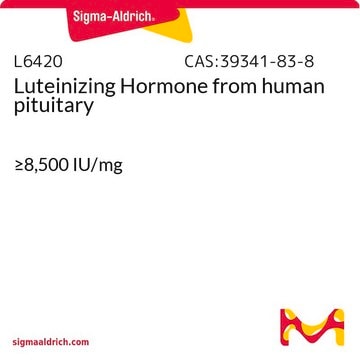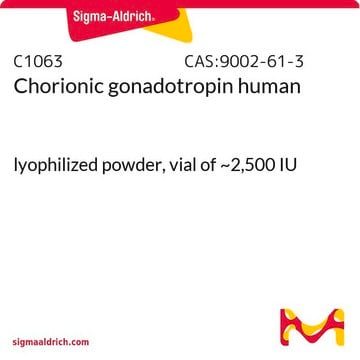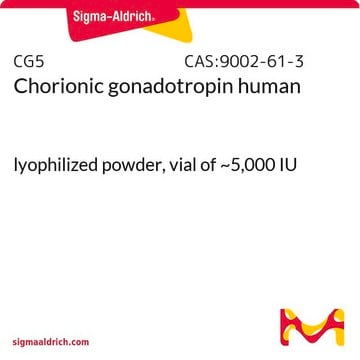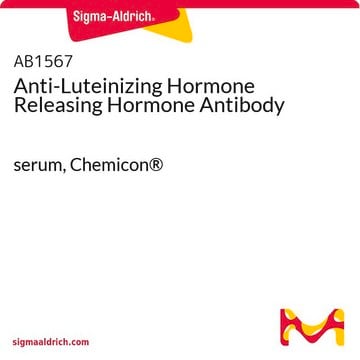L4897
Luteinizing hormone releasing hormone salmon
≥97% (HPLC)
Synonym(e):
GnRH, Gonadoliberin, Gonadotropin releasing hormone, LH-RH
About This Item
Empfohlene Produkte
Qualitätsniveau
Assay
≥97% (HPLC)
Lagertemp.
−20°C
SMILES String
CC(C)CC(NC(=O)C(Cc1c[nH]c2ccccc12)NC(=O)CNC(=O)C(Cc3ccc(O)cc3)NC(=O)C(CO)NC(=O)C(Cc4c[nH]c5ccccc45)NC(=O)C(Cc6cnc[nH]6)NC(=O)C7CCC(=O)N7)C(=O)N8CCCC8C(=O)NCC(N)=O
InChI
1S/C60H73N15O13/c1-32(2)20-47(60(88)75-19-7-12-49(75)59(87)65-28-50(61)78)73-55(83)44(22-34-25-63-40-10-5-3-8-38(34)40)69-52(80)29-66-53(81)43(21-33-13-15-37(77)16-14-33)70-58(86)48(30-76)74-56(84)45(23-35-26-64-41-11-6-4-9-39(35)41)71-57(85)46(24-36-27-62-31-67-36)72-54(82)42-17-18-51(79)68-42/h3-6,8-11,13-16,25-27,31-32,42-49,63-64,76-77H,7,12,17-24,28-30H2,1-2H3,(H2,61,78)(H,62,67)(H,65,87)(H,66,81)(H,68,79)(H,69,80)(H,70,86)(H,71,85)(H,72,82)(H,73,83)(H,74,84)
InChIKey
NMJREATYWWNIKX-UHFFFAOYSA-N
Angaben zum Gen
human ... GNRH1(2796) , GNRHR(2798)
mouse ... GNRH1(14714) , GNRHR(14715)
rat ... GNRH1(25194) , GNRHR(81668)
Amino Acid Sequence
Anwendung
Biochem./physiol. Wirkung
Sonstige Hinweise
Signalwort
Danger
H-Sätze
P-Sätze
Gefahreneinstufungen
Repr. 1B
Lagerklassenschlüssel
6.1C - Combustible acute toxic Cat.3 / toxic compounds or compounds which causing chronic effects
WGK
WGK 3
Flammpunkt (°F)
Not applicable
Flammpunkt (°C)
Not applicable
Persönliche Schutzausrüstung
Eyeshields, Gloves, type P3 (EN 143) respirator cartridges
Analysenzertifikate (COA)
Suchen Sie nach Analysenzertifikate (COA), indem Sie die Lot-/Chargennummer des Produkts eingeben. Lot- und Chargennummern sind auf dem Produktetikett hinter den Wörtern ‘Lot’ oder ‘Batch’ (Lot oder Charge) zu finden.
Besitzen Sie dieses Produkt bereits?
In der Dokumentenbibliothek finden Sie die Dokumentation zu den Produkten, die Sie kürzlich erworben haben.
Unser Team von Wissenschaftlern verfügt über Erfahrung in allen Forschungsbereichen einschließlich Life Science, Materialwissenschaften, chemischer Synthese, Chromatographie, Analytik und vielen mehr..
Setzen Sie sich mit dem technischen Dienst in Verbindung.![[des-Gly10, D-Ala6]-LH-RH-Ethylamid -acetat (Salz) Hydrat ≥97% (HPLC), powder](/deepweb/assets/sigmaaldrich/product/structures/150/195/13e08743-1592-4a6b-937d-559f571a2193/640/13e08743-1592-4a6b-937d-559f571a2193.png)



![[D-Ala6]-LH-RH acetate salt hydrate ≥97% (HPLC)](/deepweb/assets/sigmaaldrich/product/structures/222/268/0818f701-a831-440e-9dd2-5f851035c421/640/0818f701-a831-440e-9dd2-5f851035c421.png)





